An Attempt to Assess Recovery/Recrystallization Kinetics in Tungsten at High Temperature Using Statistical Nanoindentation Analysis
Abstract
1. Introduction
2. Theory
2.1. Recrystallization/Recovery
2.2. Statistical Nanoindentation Theory
3. Materials and Methods
4. Results and Discussion
5. Conclusions
- The statistical nanoindentation analysis can help to separate contributions of recovery/recrystallization mechanisms to macroscopic softening;
- Recovery/recrystallization mechanisms can be investigated even when they overlap;
- The restoration-induced softening fraction estimated from hardness measurements is always higher than the fraction recrystallized estimated from statistical nanoindentation analysis or EBSD measurements;
- The nanoindentation hardness standard deviation is maximal when the softening fraction approaches 50% and is minimal both for the initial state and for the fully recrystallized state;
- The statistical nanoindentation analysis is a complementary approach to EBSD measurements to investigate the effect of deformed structure upon the competition between thermally activated restoration processes, such as recovery/recrystallization mechanisms.
Author Contributions
Funding
Acknowledgments
Conflicts of Interest
References
- Hirai, T.; Panayotis, S.; Barabash, V.; Amzallag, C.; Escourbiac, F.; Durocher, A.; Merola, M.; Linke, J.; Loewenhoff, T.; Pintsuk, G.; et al. Use of tungsten material for the ITER divertor. Nucl. Mater. Energy 2016, 9, 616–622. [Google Scholar] [CrossRef]
- Durif, A.; Richou, M.; Kermouche, G.; Lenci, M.; Bergheau, J. Impact of tungsten recrystallization on ITER-like components for lifetime estimation. Fusion Eng. Des. 2019, 138, 247–253. [Google Scholar] [CrossRef]
- Humphreys, F.J.; Hatherly, M. Recrystallization and Related Annealing Phenomena; Elsevier: Amsterdam, The Netherlands, 2012. [Google Scholar]
- Pintsuk, G.; Antusch, S.; Weingaertner, T.; Wirtz, M. Recrystallization and composition dependent thermal fatigue response of different tungsten grades. Int. J. Refract. Met. Hard Mater. 2018, 72, 97–103. [Google Scholar] [CrossRef]
- Wirtz, M.; Linke, J.; Loewenhoff, T.; Pintsuk, G.; Uytdenhouwen, I. Transient heat load challenges for plasma-facing materials during long-term operation. Nucl. Mater. Energy 2017, 12, 148–155. [Google Scholar] [CrossRef]
- Richou, M.; Durif, A.; Lenci, M.; Mondon, M.; Minissale, M.; Gallais, L.; Kermouche, G.; De Temmerman, G. Recrystallization at high temperature of two tungsten materials complying with the ITER specifications. J. Nucl. Mater. 2020, 542, 152418. [Google Scholar] [CrossRef]
- Minissale, M.; Durif, A.; Hiret, P.; Vidal, T.; Faucheux, J.; Lenci, M.; Mondon, M.; Kermouche, G.; Pontillon, Y.; Grisolia, C.; et al. A high power laser facility to conduct annealing tests at high temperature. Rev. Sci. Instrum. 2020, 91, 035102. [Google Scholar] [CrossRef]
- Tarasiuk, J.; Gerber, P.; Bacroix, B. Estimation of recrystallized volume fraction from EBSD data. Acta Mater. 2002, 50, 1467–1477. [Google Scholar] [CrossRef]
- Moussa, C.; Bernacki, M.; Besnard, R.; Bozzolo, N. About quantitative EBSD analysis of deformation and recovery substructures in pure Tantalum. In IOP Conference Series: Materials Science and Engineering; IOP Publishing: Bristol, UK, 2015; Volume 89, p. 012038. [Google Scholar]
- Bozzolo, N.; Jacomet, S.; Logé, R.E. Fast in-situ annealing stage coupled with EBSD: A suitable tool to observe quick recrystallization mechanisms. Mater. Charact. 2012, 70, 28–32. [Google Scholar] [CrossRef]
- Lopez-Sanchez, M.A.; Tommasi, A.; Barou, F.; Quey, R. Dislocation-driven recrystallization in AZ31B magnesium alloy imaged by quasi-in situ EBSD in annealing experiments. Mater. Charact. 2020, 165, 110382. [Google Scholar] [CrossRef]
- Oliver, W.C.; Pharr, G.M. An improved technique for determining hardness and elastic modulus using load and displacement sensing indentation experiments. J. Mater. Res. 1992, 7, 1564–1583. [Google Scholar] [CrossRef]
- Guillonneau, G.; Kermouche, G.; Bec, S.; Loubet, J.L. A simple method to minimize displacement measurement uncertainties using dynamic nanoindentation testing. Tribol. Int. 2014, 70, 190–198. [Google Scholar] [CrossRef]
- Zayachuk, Y.; Armstrong, D.; Bystrov, K.; Van Boxel, S.; Morgan, T.; Roberts, S. Nanoindentation study of the combined effects of crystallography, heat treatment and exposure to high-flux deuterium plasma in tungsten. J. Nucl. Mater. 2017, 486, 183–190. [Google Scholar] [CrossRef]
- Constantinides, G.; Chandran, K.R.; Ulm, F.J.; Van Vliet, K. Grid indentation analysis of composite microstructure and mechanics: Principles and validation. Mater. Sci. Eng. A 2006, 430, 189–202. [Google Scholar] [CrossRef]
- Randall, N.X.; Vandamme, M.; Ulm, F.J. Nanoindentation analysis as a two-dimensional tool for mapping the mechanical properties of complex surfaces. J. Mater. Res. 2009, 24, 679–690. [Google Scholar] [CrossRef]
- Nes, E. Recovery revisited. Acta Metall. Mater. 1995, 43, 2189–2207. [Google Scholar] [CrossRef]
- Verdier, M.; Brechet, Y.; Guyot, P. Recovery of AlMg alloys: Flow stress and strain-hardening properties. Acta Mater. 1998, 47, 127–134. [Google Scholar] [CrossRef]
- Friedel, J. Dislocations: International Series of Monographs on Solid State Physics; Elsevier: Amsterdam, The Netherlands, 2013; Volume 3. [Google Scholar]
- Ciucani, U.M.; Thum, A.; Devos, C.; Pantleon, W. Recovery and recrystallization kinetics of differently rolled, thin tungsten plates in the temperature range from 1325 °C to 1400 °C. Nucl. Mater. Energy 2019, 20, 100701. [Google Scholar] [CrossRef]
- Vandermeer, R.; Hansen, N. Recovery kinetics of nanostructured aluminum: Model and experiment. Acta Mater. 2008, 56, 5719–5727. [Google Scholar] [CrossRef]
- Cheng, Y.T.; Cheng, C.M. Scaling, dimensional analysis, and indentation measurements. Mater. Sci. Eng. R Rep. 2004, 44, 91–149. [Google Scholar] [CrossRef]
- Kermouche, G.; Loubet, J.L.; Bergheau, J.M. An approximate solution to the problem of cone or wedge indentation of elastoplastic solids. C. R. Méc. 2005, 333, 389–395. [Google Scholar] [CrossRef]
- Sanchez-Camargo, C.M.; Hor, A.; Salem, M.; Mabru, C. A robust method for mechanical characterization of heterogeneous materials by nanoindentation grid analysis. Mater. Des. 2020, 194, 108908. [Google Scholar] [CrossRef]
- Nix, W.D.; Gao, H. Indentation size effects in crystalline materials: A law for strain gradient plasticity. J. Mech. Phys. Solids 1998, 46, 411–425. [Google Scholar] [CrossRef]
- Bachmann, F.; Hielscher, R.; Schaeben, H. Grain detection from 2d and 3d EBSD data—Specification of the MTEX algorithm. Ultramicroscopy 2011, 111, 1720–1733. [Google Scholar] [CrossRef] [PubMed]
- Hadadzadeh, A.; Mokdad, F.; Wells, M.; Chen, D. A new grain orientation spread approach to analyze the dynamic recrystallization behavior of a cast-homogenized Mg-Zn-Zr alloy using electron backscattered diffraction. Mater. Sci. Eng. A 2018, 709, 285–289. [Google Scholar] [CrossRef]
- Ayad, A.; Ramoul, M.; Rollett, A.; Wagner, F. Quantifying primary recrystallization from EBSD maps of partially recrystallized states of an IF steel. Mater. Charact. 2020, 110773. [Google Scholar] [CrossRef]
- Baral, P.; Laurent-Brocq, M.; Guillonneau, G.; Bergheau, J.M.; Loubet, J.L.; Kermouche, G. In situ characterization of AA1050 recrystallization kinetics using high temperature nanoindentation testing. Mater. Des. 2018, 152, 22–29. [Google Scholar] [CrossRef]
- Alfonso, A.; Jensen, D.J.; Luo, G.N.; Pantleon, W. Thermal stability of a highly-deformed warm-rolled tungsten plate in the temperature range 1100–1250 °C. Fusion Eng. Des. 2015, 98, 1924–1928. [Google Scholar] [CrossRef]
- Tabor, D. The Hardness of Metals; Oxford University Press: Oxford, UK, 2000. [Google Scholar]
- Cottrell, A. Theory of dislocations. Prog. Met. Phys. 1949, 1, 77–126. [Google Scholar] [CrossRef]
- Wei, Q.; Kecskes, L. Effect of low-temperature rolling on the tensile behavior of commercially pure tungsten. Mater. Sci. Eng. A 2008, 491, 62–69. [Google Scholar] [CrossRef]
- Lassner, E.; Schubert, W.D. Properties, Chemistry, Technology of the Element, Alloys, and Chemical Compounds; Kluwer: Vienna, Austria, 1999. [Google Scholar]
- Hintsala, E.D.; Hangen, U.; Stauffer, D.D. High-throughput nanoindentation for statistical and spatial property determination. JOM 2018, 70, 494–503. [Google Scholar] [CrossRef]
- Raabe, D.; Roters, F.; Marx, V. Experimental investigation and numerical simulation of the correlation of recovery and texture in bcc metals and alloys. Texture Stress Microstruct. 1996, 26, 611–635. [Google Scholar] [CrossRef]
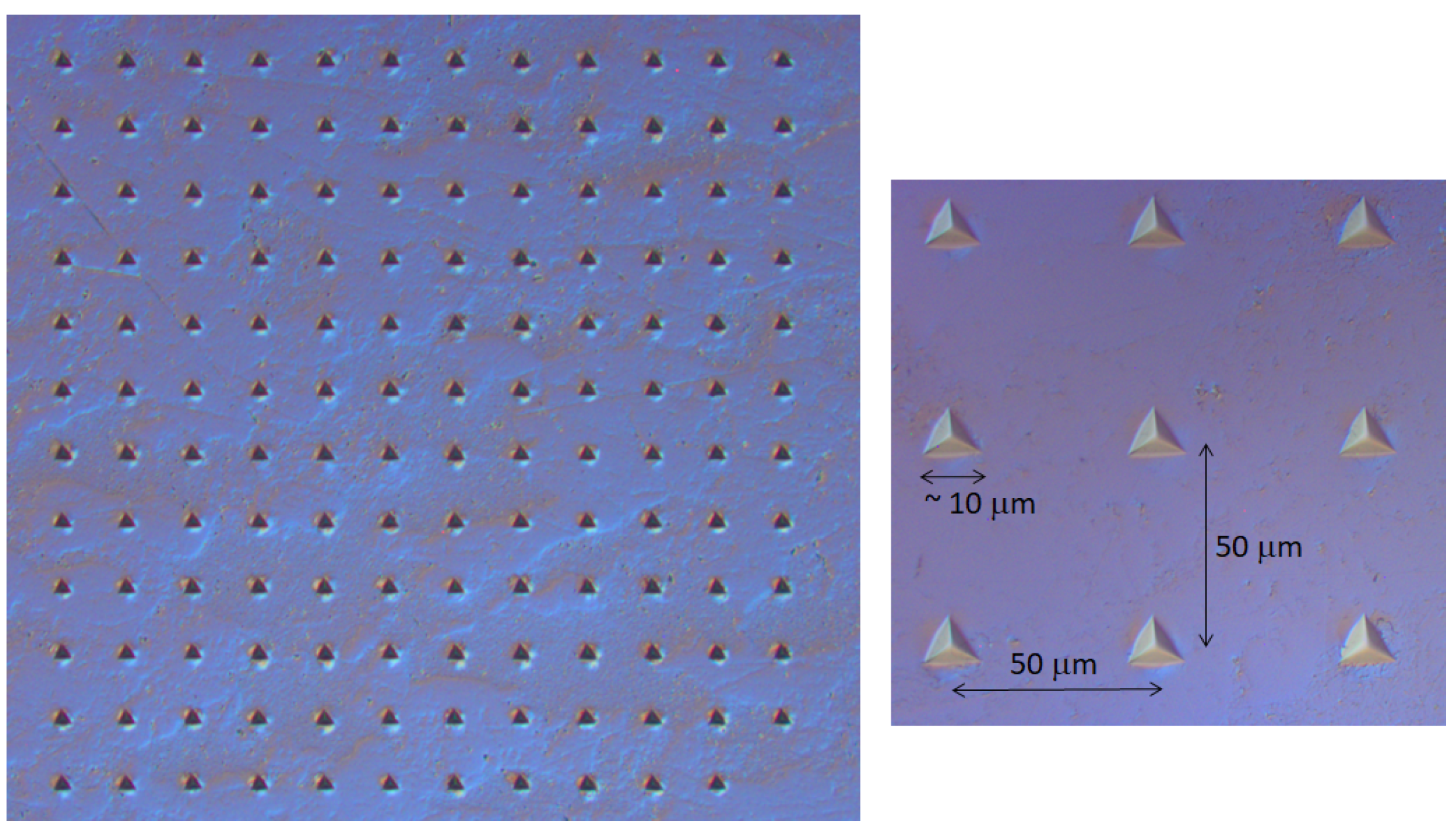
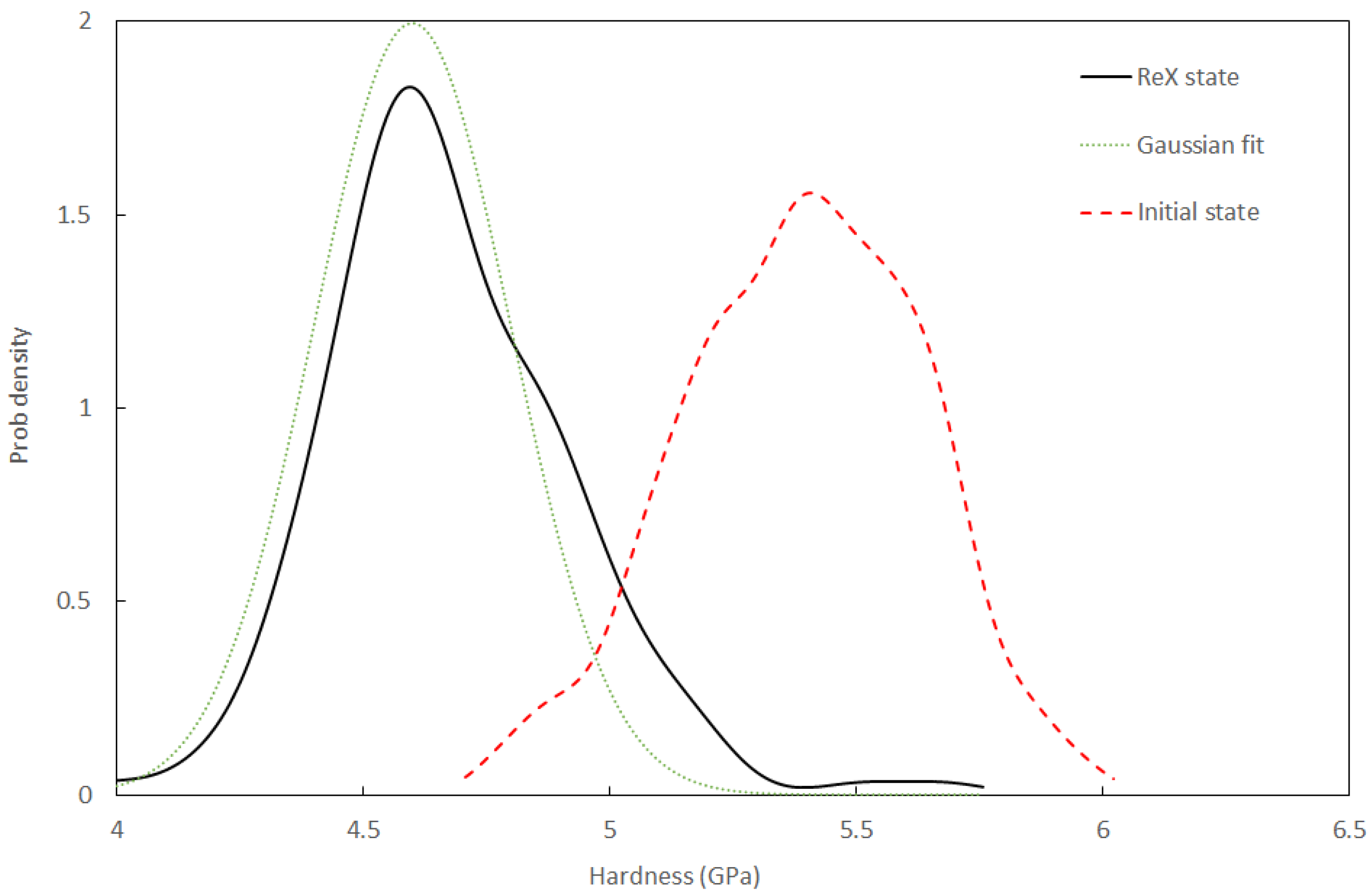

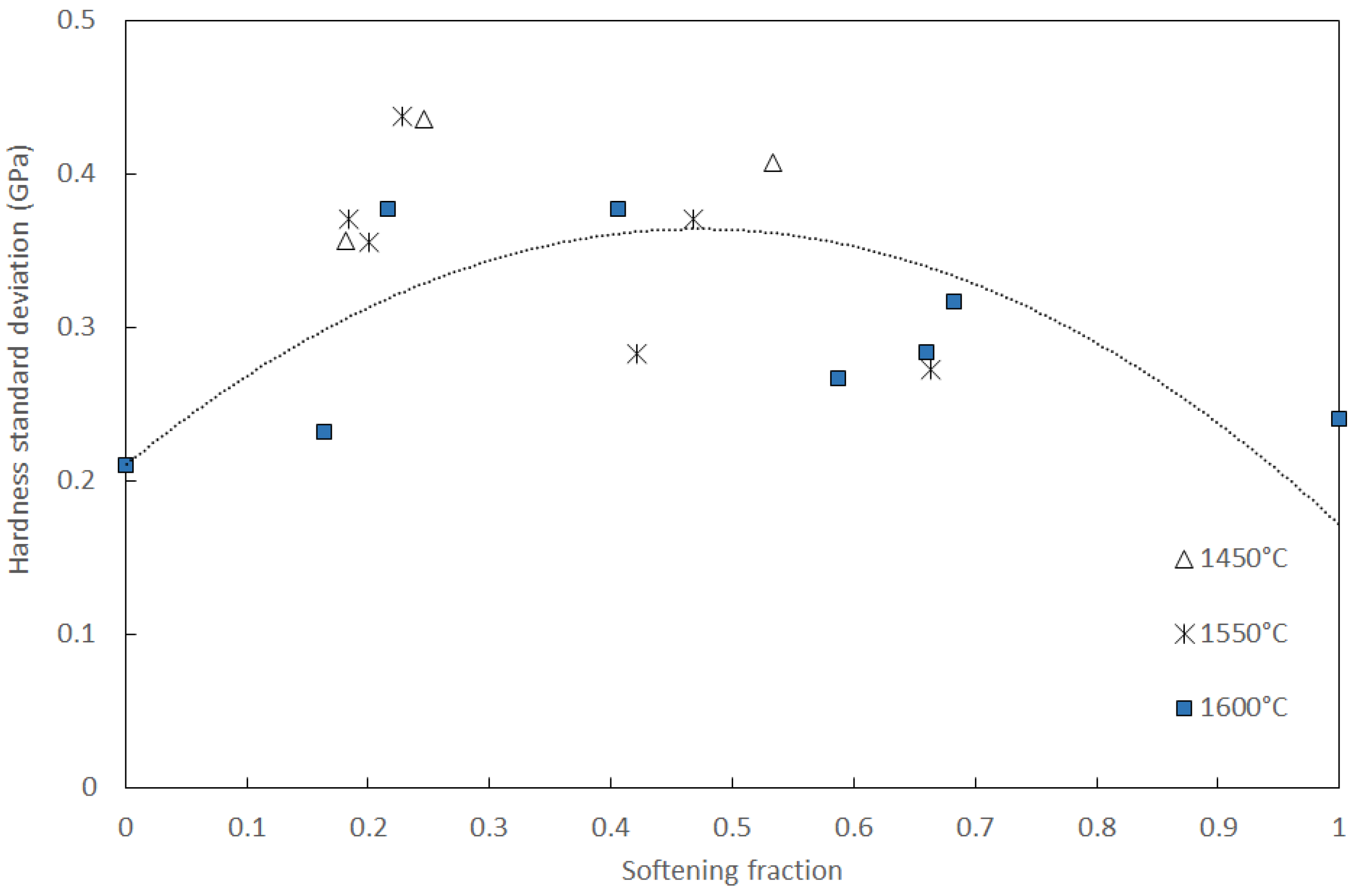
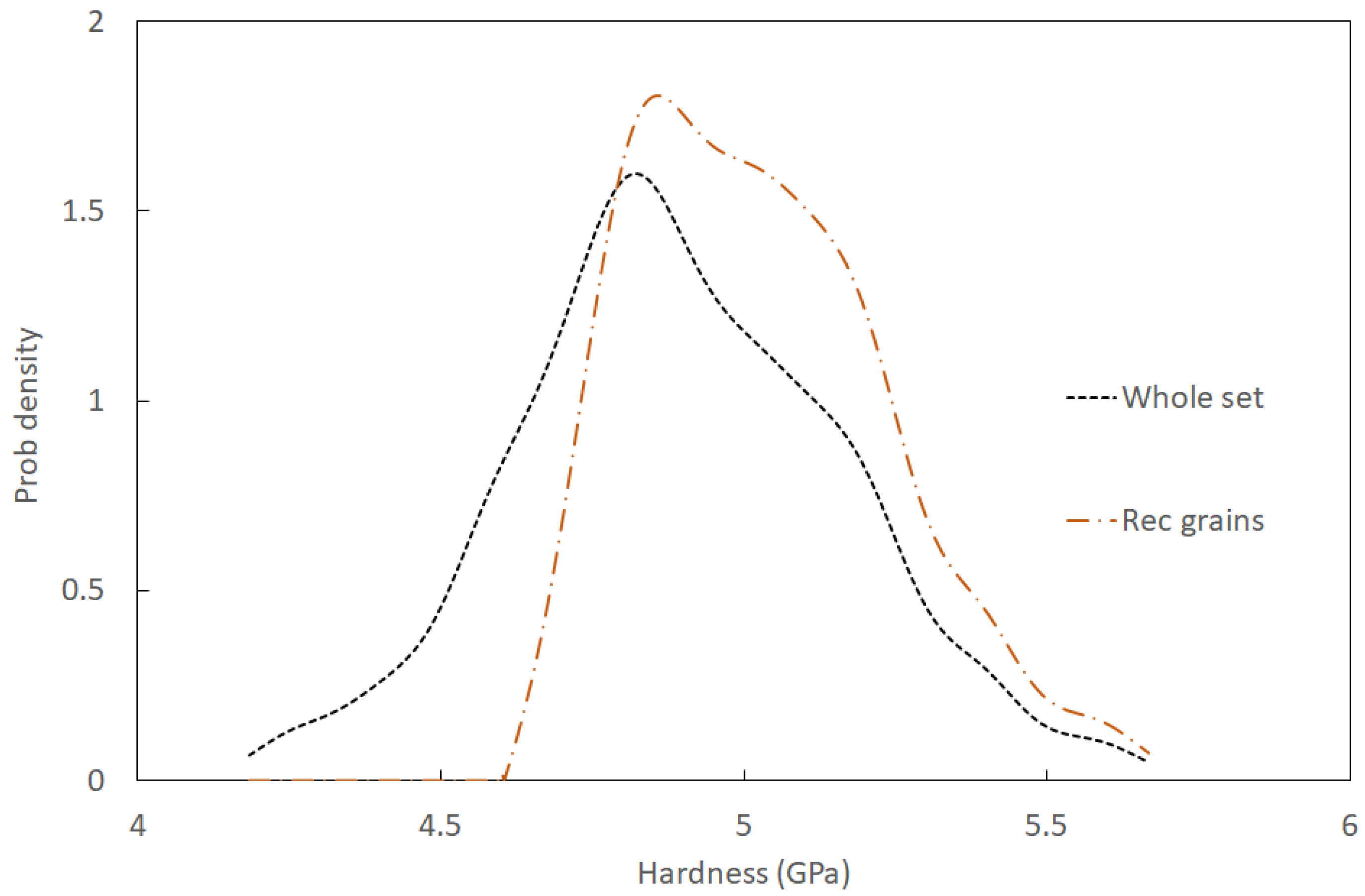
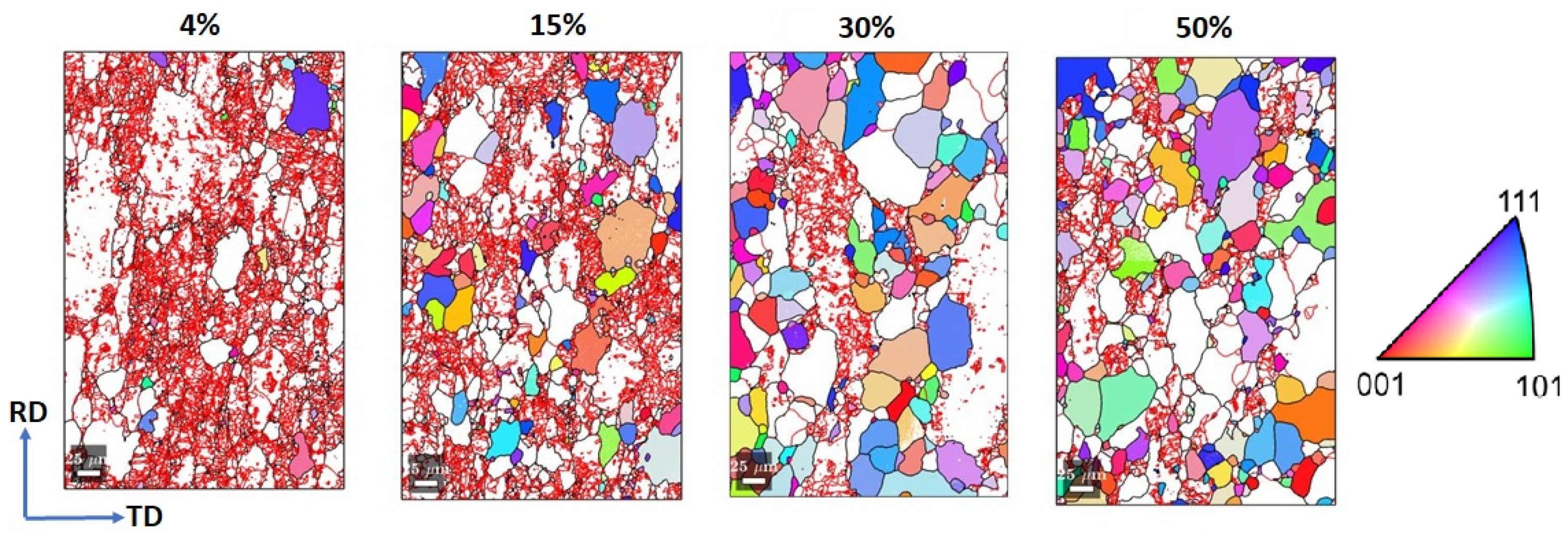
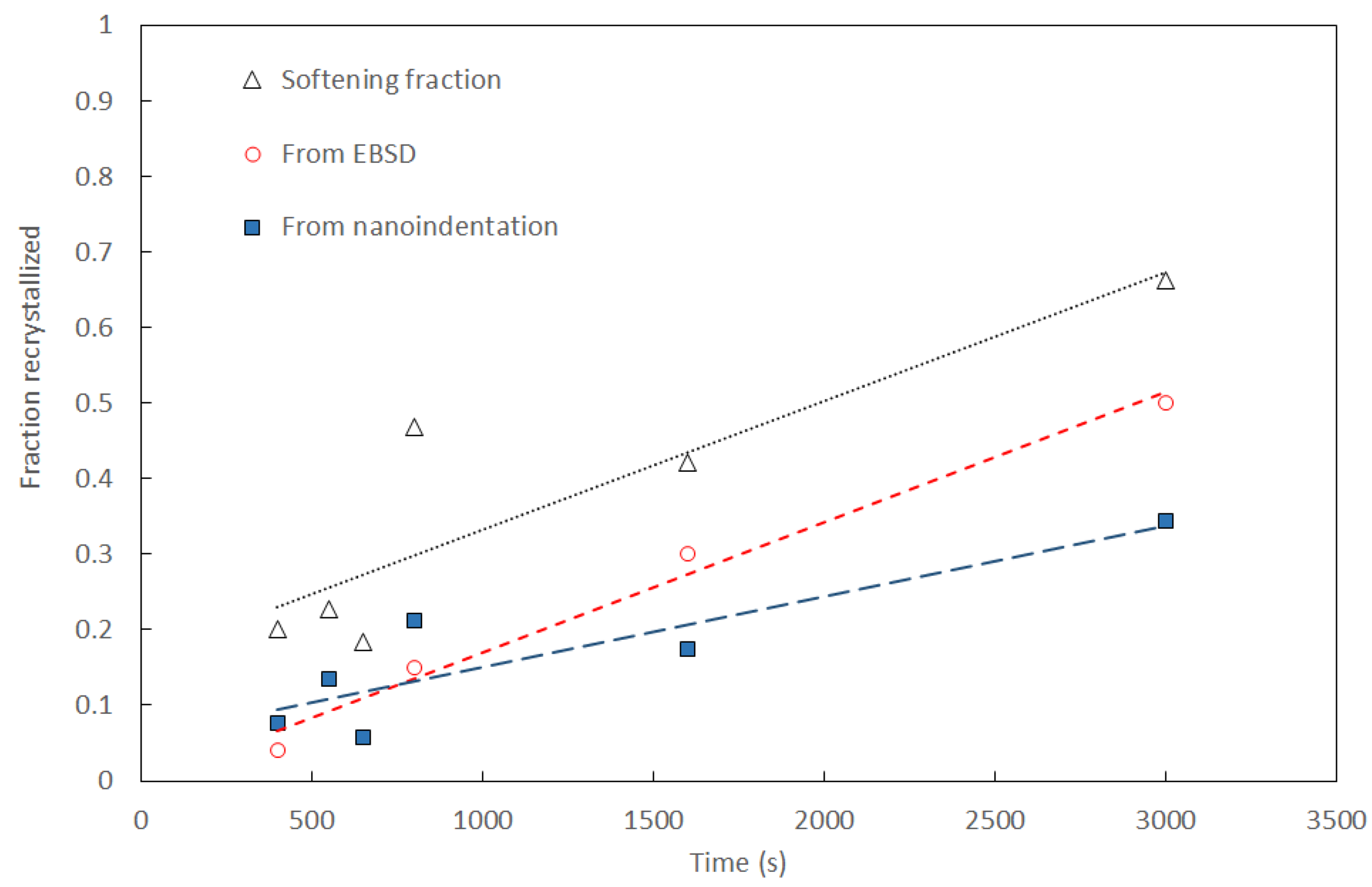
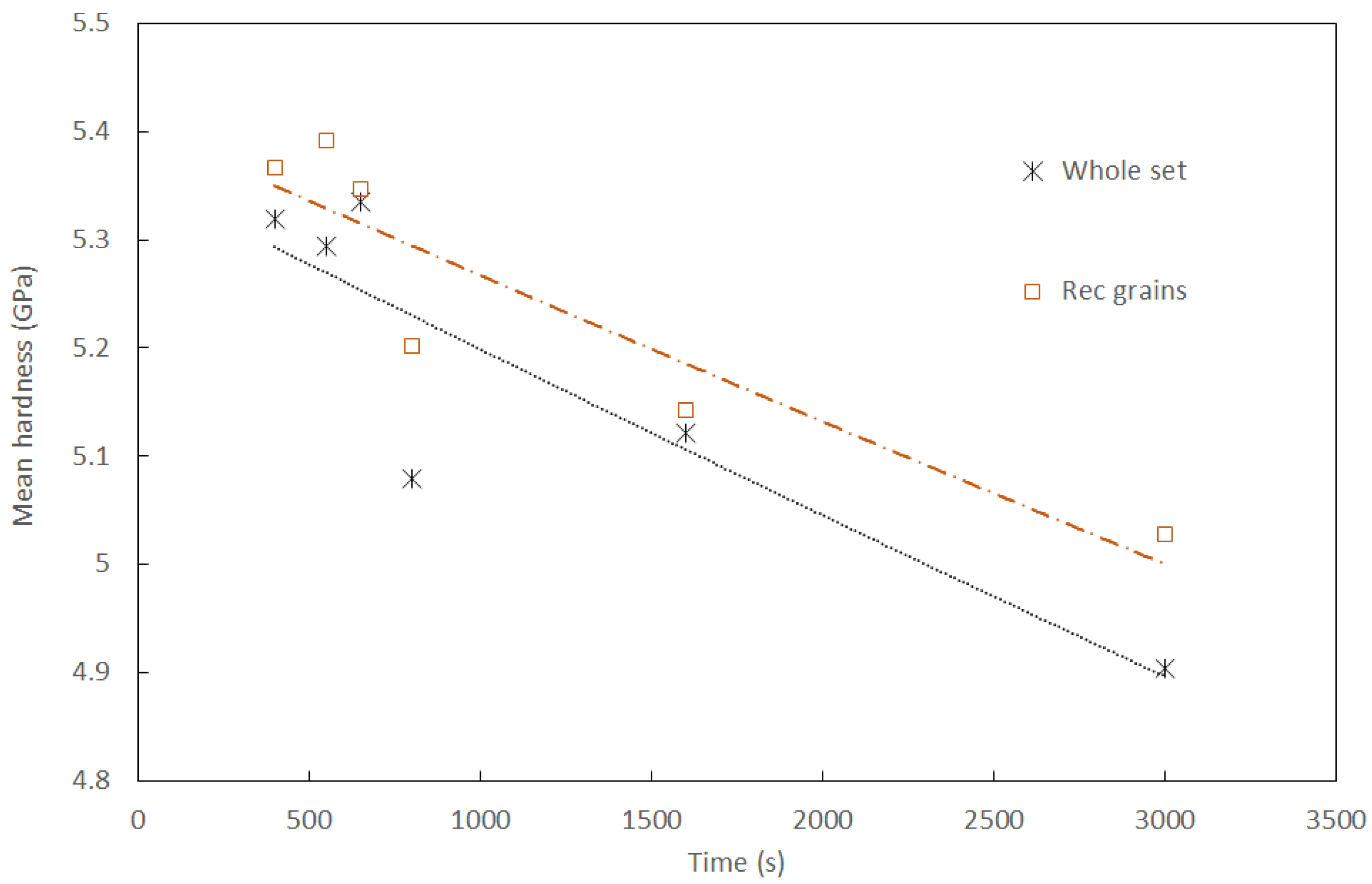
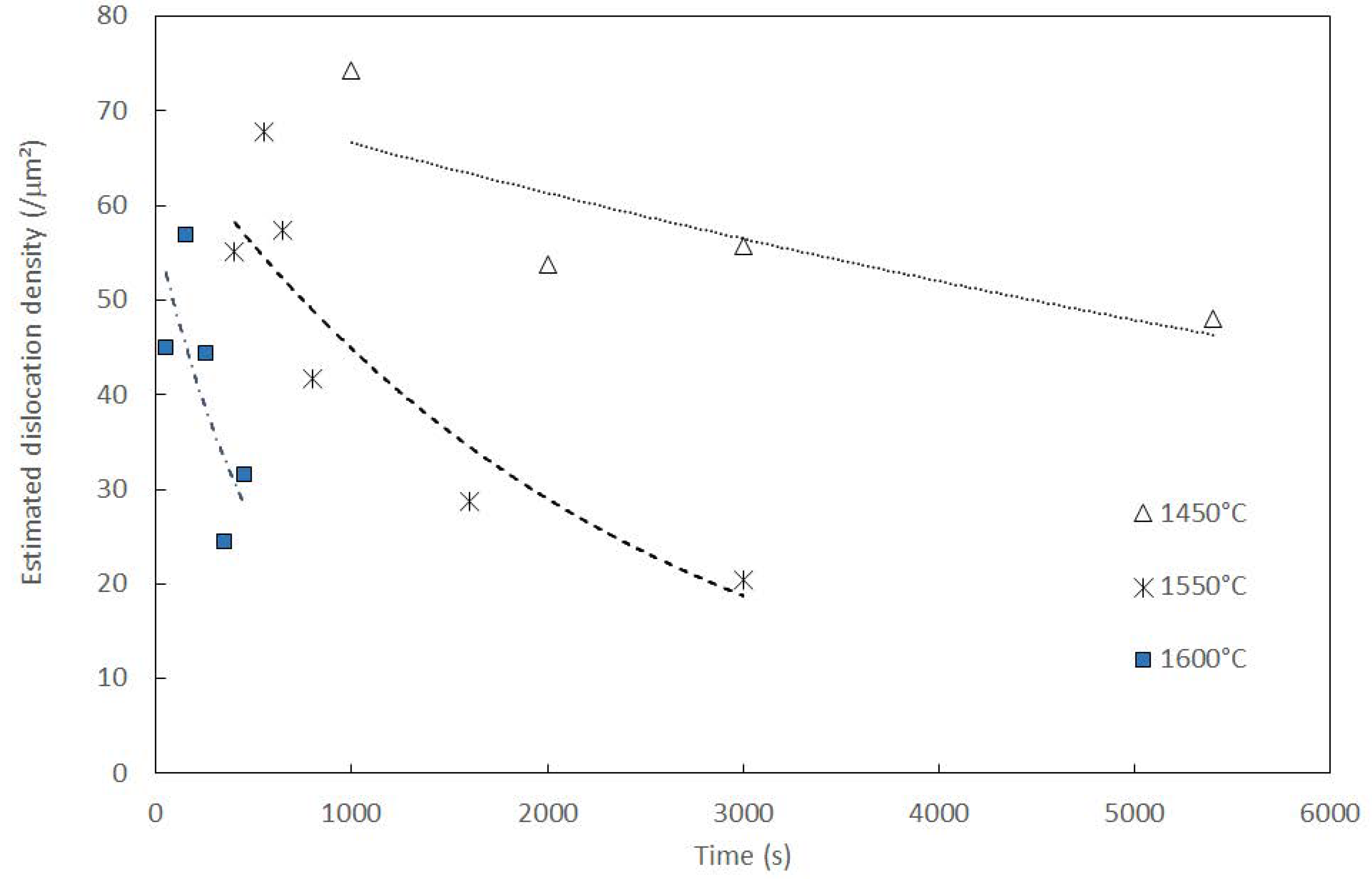
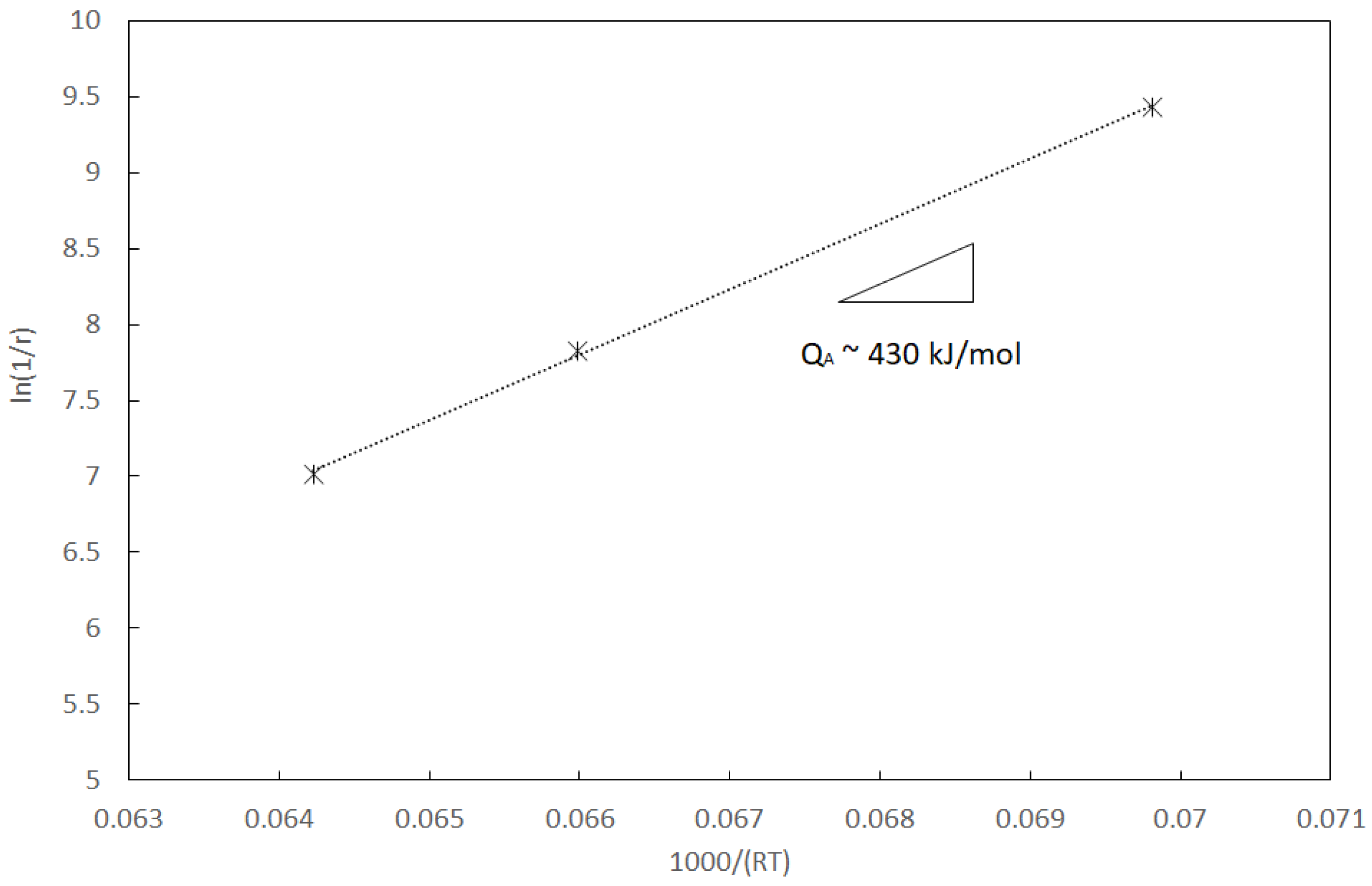
Publisher’s Note: MDPI stays neutral with regard to jurisdictional claims in published maps and institutional affiliations. |
© 2020 by the authors. Licensee MDPI, Basel, Switzerland. This article is an open access article distributed under the terms and conditions of the Creative Commons Attribution (CC BY) license (http://creativecommons.org/licenses/by/4.0/).
Share and Cite
Karanja, L.; Lenci, M.; Piot, D.; Maurice, C.; Durif, A.; Richou, M.; Gallais, L.; Minissale, M.; Kermouche, G. An Attempt to Assess Recovery/Recrystallization Kinetics in Tungsten at High Temperature Using Statistical Nanoindentation Analysis. Crystals 2021, 11, 37. https://doi.org/10.3390/cryst11010037
Karanja L, Lenci M, Piot D, Maurice C, Durif A, Richou M, Gallais L, Minissale M, Kermouche G. An Attempt to Assess Recovery/Recrystallization Kinetics in Tungsten at High Temperature Using Statistical Nanoindentation Analysis. Crystals. 2021; 11(1):37. https://doi.org/10.3390/cryst11010037
Chicago/Turabian StyleKaranja, Liz, Matthieu Lenci, David Piot, Claire Maurice, Alan Durif, Marianne Richou, Laurent Gallais, Marco Minissale, and Guillaume Kermouche. 2021. "An Attempt to Assess Recovery/Recrystallization Kinetics in Tungsten at High Temperature Using Statistical Nanoindentation Analysis" Crystals 11, no. 1: 37. https://doi.org/10.3390/cryst11010037
APA StyleKaranja, L., Lenci, M., Piot, D., Maurice, C., Durif, A., Richou, M., Gallais, L., Minissale, M., & Kermouche, G. (2021). An Attempt to Assess Recovery/Recrystallization Kinetics in Tungsten at High Temperature Using Statistical Nanoindentation Analysis. Crystals, 11(1), 37. https://doi.org/10.3390/cryst11010037





